Subpixel Snow Mapping Using Daily AVHRR/2 Data over Qinghai–Tibet Plateau
Abstract
:1. Introduction
2. Materials and Methods
2.1. Study Area and Satellite Data
2.1.1. Study Area
2.1.2. Satellite Data
2.2. Cloud Removal for the AVHRR/2 Images
2.2.1. Cloud Types
- Low clouds
- Medium clouds
- High clouds
2.2.2. The Identification of Clouds from AVHRR/2 Images
- Identifying low clouds from AVHRR/2 images
- Identifying medium clouds from AVHRR/2 images
- Identifying high clouds from AVHRR/2 images
- Identifying thin clouds from AVHRR/2 images
2.2.3. The Substitution of Cloud Pixels in the AVHRR/2 Images
2.2.4. Contrasting Cloud Removed Images with Their Source Images
2.3. Subpixel Snow Mapping Using Daily AVHRR/2 Data
2.3.1. Linear Spectral Mixture Model
2.3.2. Approach to Selecting Multiple Snow and Non-Snow End-Members
- Extraction of snow end-members from AVHRR/2 data
- Extraction of non-snow end-members from AVHRR/2 data
- Rules for extracting the end-members of bare land
- 2.
- Rules for extracting the end-members of vegetation
- 3.
- Rules for extracting the end-members of water
2.3.3. The Unmixing of Mixed Pixels in AVHRR/2 Images
- Selection of snow end-members and non-snow end-members according to the above rules of extracting end-members
- Approaches to using snow and non-snow end-members in the unmixing of mixed pixels in AVHRR/2 images
2.3.4. Subpixel Snow Mapping through a Look-Up Table
- Look-up table and sample spectra
- Approach to selecting the sample spectra from AVHRR/2 images
- For an AVHRR/2 image, the reflectance of all its mixed pixels are multiplied by 1000, then the values of reflectance are changed into integers, from 0 to 1000;
- According to the reflectance integral values of channel 1, the mixed pixels of the same reflectance value constitute one pixel group; that is, all the mixed pixels are divided into 1001 pixel groups because the reflectance has 1001 kinds of integral values in total;
- According to the reflectance value distribution of channel 2, each pixel group is also divided into several pixel subgroups. In one pixel group, if there are some pixel clusters with close channel 2 reflectance values, each pixel cluster serves as a subgroup. Then, from each pixel subgroup, one pixel, which best represents all the pixels of the subgroup, is selected as the sample pixel of that subgroup, and its spectrum is also the sample spectrum. Generally, the pixel is the spectral mean value of the subgroup.
- How to use the look-up table
- The difference sum between the NDVI values, and band 1 and band 2 reflectance values of the mixed pixel and its most similar sample pixel is the smallest among all the difference sums between the mixed pixel and sample pixels;
- The respective differences between the NDVI values, and band 1 and band 2 reflectance values of the mixed pixel and its most similar sample pixel are not greater than their difference sum. For example, the difference between NDVI values, as well as band 1 or band 2 reflectance values, must be less than the difference sum of the three kinds of data between the mixed pixel and its most similar sample pixel.
- Comparison between the subpixel snow mappings using the look-up table and without using the look-up table
2.3.5. Steps of the Subpixel Snow Mapping of Qinghai–Tibet Plateau Using Daily AVHRR/2 Data
- According to the above algorithm of cloud removal, the cloud-removed AVHRR/2 data are obtained. In the research, the clouds must be removed from the AVHRR/2 data first, before the AVHRR/2 data are used in the subpixel snow mapping;
- According to the above approach of end-member selection, all the pixels of a certain AVHRR/2 image are divided into three classes, i.e., snow end-members, non-snow end-members, and mixed pixels;
- Using the unmixing calculation, the snow area percentage of the mixed pixels is obtained. In addition, the pure pixels serving as snow and non-snow end-members are added directly to the results of the subpixel snow mapping, and do not join the unmixing calculation. The unmixing process of the mixed pixels is as follows:
- According to the above selection approach of sample spectra, sample pixels are selected from the AVHRR/2 image, and the sample spectra obtained;
- The sample spectra are unmixed using the above algorithm of spectral mixture, and the snow area percent of sample spectra obtained. Then, a look-up table of the sample spectra and their own snow area percentage can be established;
- Each mixed pixel of the AVHRR/2 image is compared to all the sample pixels in the look-up table. The snow area percentage is equal to that of the sample pixel with the most similar spectrum;
- The fractional snow cover of the mixed pixels, plus those of snow end-members and non-snow end-members, is the final result of the subpixel snow mapping. Thus, the snow-covered area of the AVHRR/2 image includes fractional snow covers of the mixed pixels and snow end-members.
3. Results
3.1. Validation of the Subpixel Snow Mapping
3.1.1. Thematic Mapper (TM) Data and Their Processing
3.1.2. The Extraction of Snow Cover from the TM Data
3.1.3. Validation of the Subpixel Snow Mapping
3.2. The Results of Comparing to the TM Data
4. Discussion
5. Conclusions
Author Contributions
Funding
Data Availability Statement
Conflicts of Interest
References
- Painter, T.H.; Roberts, D.A.; Green, R.O.; Dozier, J. The effect of grain size on spectral mixture analysis of snow-covered area from AVIRIS. Remote Sens. Environ. 1998, 65, 320–332. [Google Scholar] [CrossRef]
- Painter, T.H.; Dozier, J.; Roberts, D.A.; Divis, R.E.; Green, R.O. Retrieval of subpixel snow-covered area and grain size from imaging spectrometer data. Remote Sens. Environ. 2003, 85, 64–77. [Google Scholar] [CrossRef] [Green Version]
- Painter, T.H.; Rittger, K.; McKenzie, C.; Slaughter, P.; Divis, R.E.; Dozier, J. Retrieval of subpixel snow covered area, grain size, and albedo from MODIS. Remote Sens. Environ. 2009, 113, 868–879. [Google Scholar] [CrossRef] [Green Version]
- Salomonson, V.V.; Appel, I. Estimating fractional snow cover from MODIS using the normalized difference snow index. Remote Sens. Environ. 2004, 89, 351–360. [Google Scholar] [CrossRef]
- Salomonson, V.V.; Appel, I. Development of the Aqua MODIS NDSI fractional snow cover algorithm and validation results. IEEE Trans. Geosci. Remote Sen. 2006, 44, 1747–1756. [Google Scholar] [CrossRef]
- Illiyana, D.D.; Andrew, G.K. Fractional snow cover mapping through artificial neural network analysis of MODIS surface reflectance. Remote Sens. Environ. 2011, 115, 3355–3366. [Google Scholar]
- Kuter, S.; Akyurek, Z.; Weber, G.-W. Estimation of subpixel snow-covered area by nonparametric regression splines. Int. Arch. Photogrammety Remote Sens. Spat. Inf. Sci. 2016, 42, 31–36. [Google Scholar] [CrossRef] [Green Version]
- Zhu, J.; Shi, J.; Wang, Y. Subpixel snow mapping of the Qinghai–Tibet Plateau using MODIS data. Int. J. Appl. Earth Obs. Geoinf. 2012, 18, 251–262. [Google Scholar] [CrossRef]
- Jin, Z.; Simpson, J.J. Bidirectional anisotropic reflectance of snow and sea ice in AVHRR channel 1 and 2 spectral regions: Part I. Theoretical analysis. IEEE Trans. Geosci. Remote Sens. 1999, 37, 543–554. [Google Scholar]
- Hall, D.K.; Foster, J.L.; Salomonson, V.V.; Klein, A.G.; Chien, J.Y.L. Development of a technique to assess snow-cover mapping errors from space. IEEE Trans. Geosci. Remote Sens. 2001, 39, 432–438. [Google Scholar] [CrossRef]
- Zhu, J.; Shi, J.; Chu, H.; Wang, Y. Approaches to using end-members for sub-pixel snow mapping with MODIS data in Qinghai-Tibet Plateau. In Proceedings of the 2010 IEEE International Geoscience and Remote Sensing Symposium (IGARSS 2010), Honolulu, HI, USA, 25–30 July 2010; pp. 1725–1728. [Google Scholar]
- Tang, Z.; Wang, J.; Li, H.; Liang, J.; Li, C.; Wang, X. Extraction and assessment of snowline altitude over the Tibetan plateau using MODIS fractional snow cover data (2001 to 2013). J. Appl. Remote Sens. 2014, 8, 084689. [Google Scholar] [CrossRef]
- Tang, Z.; Wang, X.; Wang, J.; Wang, X.; Li, H.; Jiang, Z. Spatiotemporal variation of snow cover in Tianshan Mountains, Central Asia, based on cloud-free MODIS fractional snow cover product, 2001–2015. Remote Sens. 2017, 9, 1045. [Google Scholar] [CrossRef] [Green Version]
- Tang, Z.; Wang, X.; Deng, G.; Wang, X.; Jiang, Z.; Sang, G. Spatiotemporal variation of snowline altitude at the end of melting season across High Mountain Asia, using MODIS snow cover product. Adv. Space Res. 2020, 66, 2629–2645. [Google Scholar] [CrossRef]
- Deng, G.; Tang, Z.; Hu, G.; Wang, J.; Sang, G.; Li, J. Spatiotemporal dynamics of snowline altitude and their responses to climate change in the Tienshan Mountains, Central Asia, During 2001–2019. Sustainability 2021, 13, 3992. [Google Scholar] [CrossRef]
- Metsämäki, S.; Vepsalainen, J.; Pulliainen, J.; Sucksdorff, Y. Improved linear interpolation method for the estimation of snow-covered area from optical data. Remote Sens. Environ. 2002, 82, 64–78. [Google Scholar] [CrossRef]
- Metsämäki, S.; Anttila, S.T.; Markus, H.J.; Attila, J. A feasible method for fractional snow cover mapping in boreal zone based on a reflectance model. Remote Sens. Environ. 2005, 95, 77–95. [Google Scholar] [CrossRef]
- Zhu, J.; Shi, J. An algorithm for subpixel snow mapping: Extraction of a fractional snow-covered area based on ten-day composited AVHRR/2 data of the Qinhai-Tibet Plateau. IEEE Geosci. Remote Sens. Mag. 2018, 6, 86–98. [Google Scholar] [CrossRef]
- Zheng, Z.; Liu, R.; Liu, Y. Correction to the Localization of NOAA AVHRR with DEM (Chinese). J. Appl. Meteorol. Sci. 2007, 18, 417–426. [Google Scholar]
- Satellite Products and Services Division, Direct Services Branch, NOAA. Satellite Instrument Calibration. July 2018. Available online: https://noaasis.noaa.gov/NOAASIS/ml/calibration.html (accessed on 6 July 2018).
- Zhu, Y.; Liu, J.; Bai, J. Statistical analysis on spectral and textural features of clouds. Remote Sens. Technol. Appl. 2006, 21, 18–24. (In Chinese) [Google Scholar]
- Yamanouchi, T.; Suzuki, K.; Kawaguchi, S. Detection of clouds in Antarctica from infrared multispectral data of AVHRR. J. Meteorol. Soc. Jpn. 1987, 65, 949–962. [Google Scholar] [CrossRef] [Green Version]
- Turner, J.; Marshall, G.J.; Ladkin, R.S. An operational real-time cloud detection schime for use in the Antarctic based on AVHRR data. Int. J. Remote Sens. 2001, 22, 3027–3046. [Google Scholar] [CrossRef]
- Dybbroe, A.; Karlsson, K.G.; Thoss, A. NWCSAF AVHRR Cloud Detection and Analysis Using Dynamic Thresholds and Radiative Transfer Modelling. J. Appl. Meteorol. 2005, 44, 39–54. [Google Scholar] [CrossRef]
- Kidder, S.Q.; Wu, H. Dramatic Contrast Between Low Clouds and Snow Cover in Daytime 3.7μm Imagery. Mon. Weather. Rev. 1984, 112, 2345–2346. [Google Scholar] [CrossRef] [Green Version]
- Oleson, F.S.; Grassl, H. Cloud detection and classification over oceans at night with NOAA-7. Int. J. Remote Sens. 1985, 6, 1435–1444. [Google Scholar] [CrossRef]
- Tang, Z.; Wang, J.; Li, H.; Yan, L. Spatiotemporal changes of snow cover over the Tibetan plateau based on cloud-removed moderate resolution imaging spectroradiometer fractional snow cover product from 2001 to 2011. J. Appl. Remote Sens. 2013, 7, 073582. [Google Scholar] [CrossRef]
- Vogel, S.W. Usage of high-resolution Landsat7 band 8 for single-band snow-cover classification. Ann. Glaciol. 2002, 34, 53–57. [Google Scholar] [CrossRef] [Green Version]

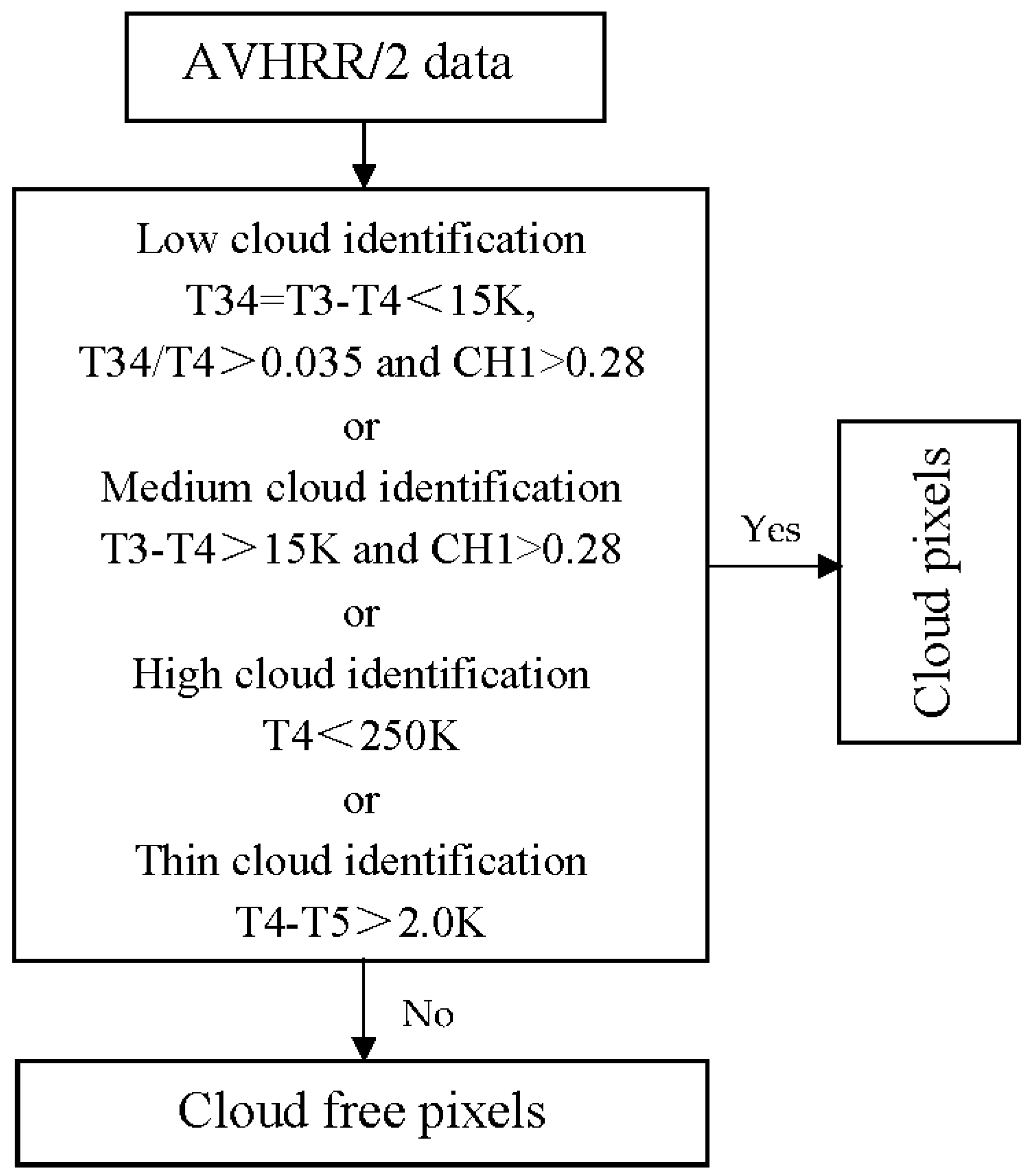
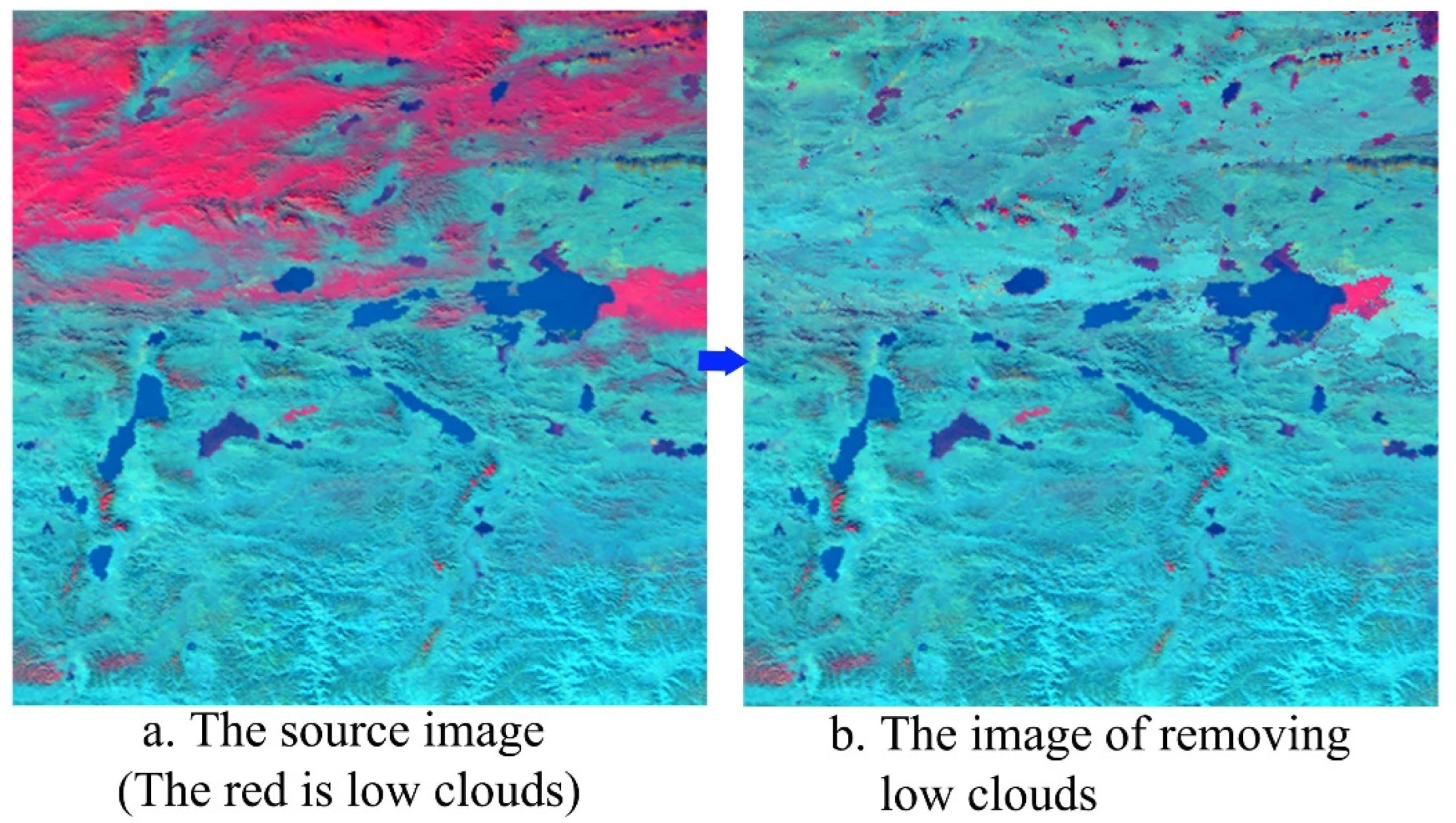
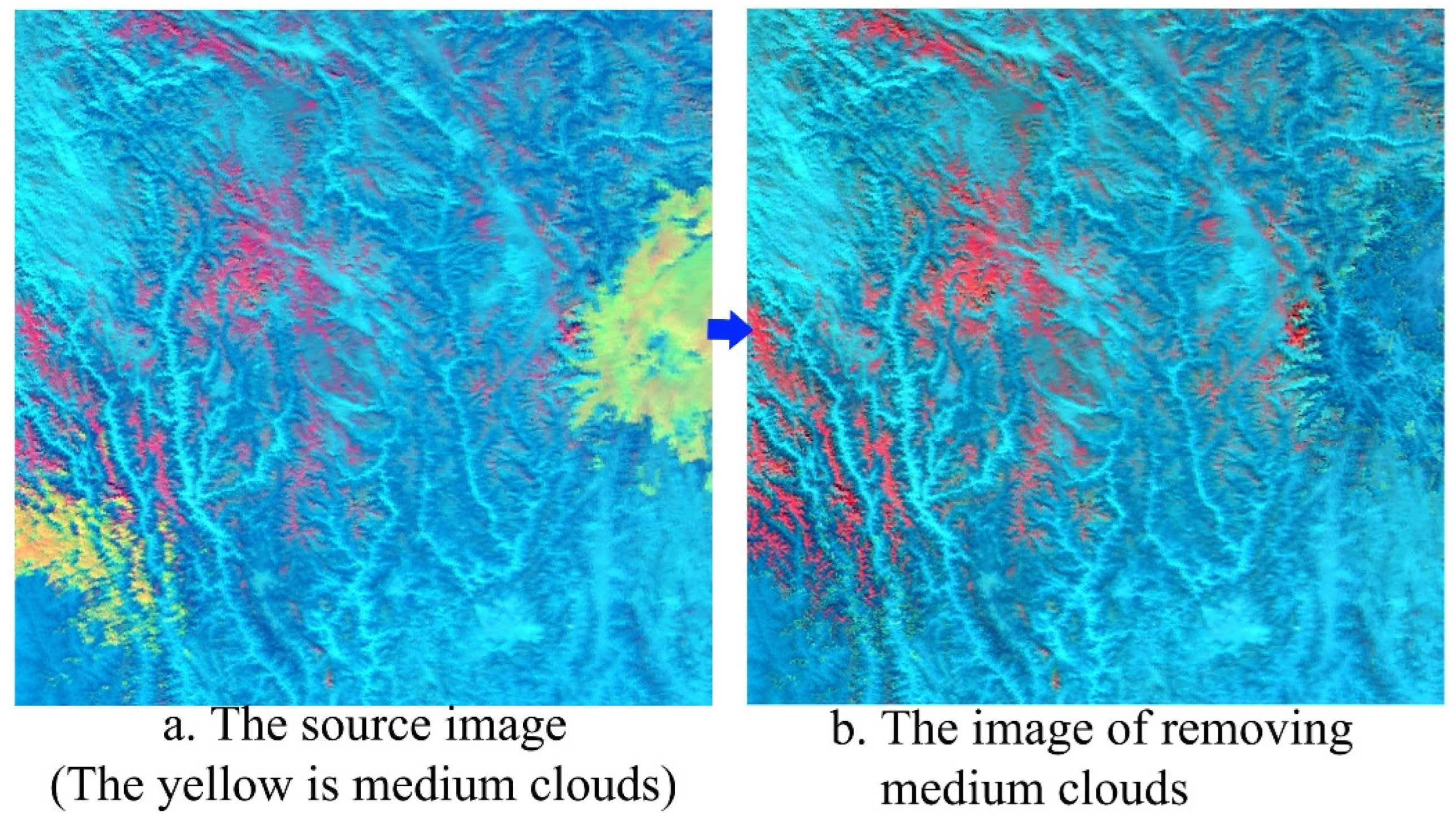

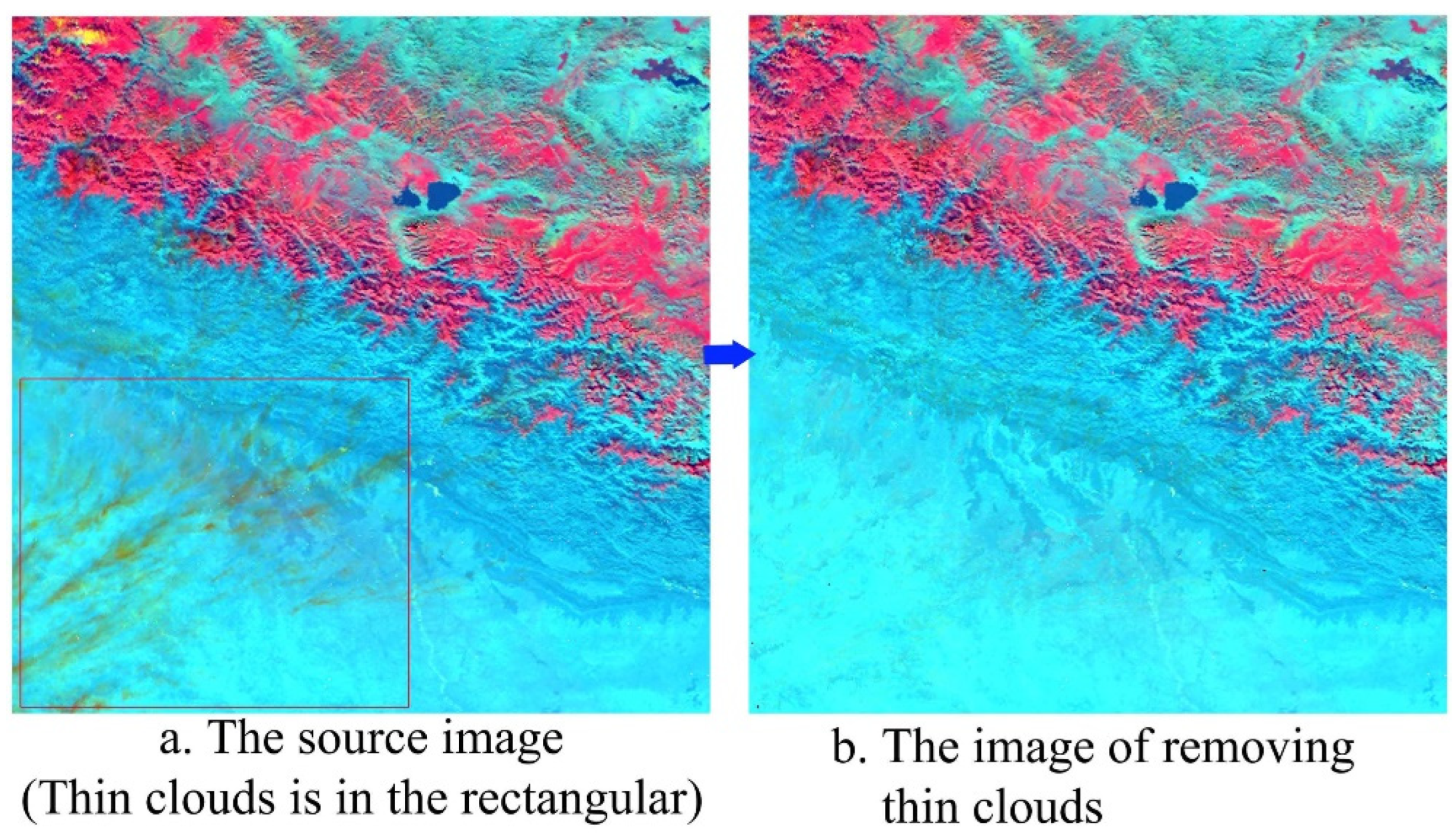
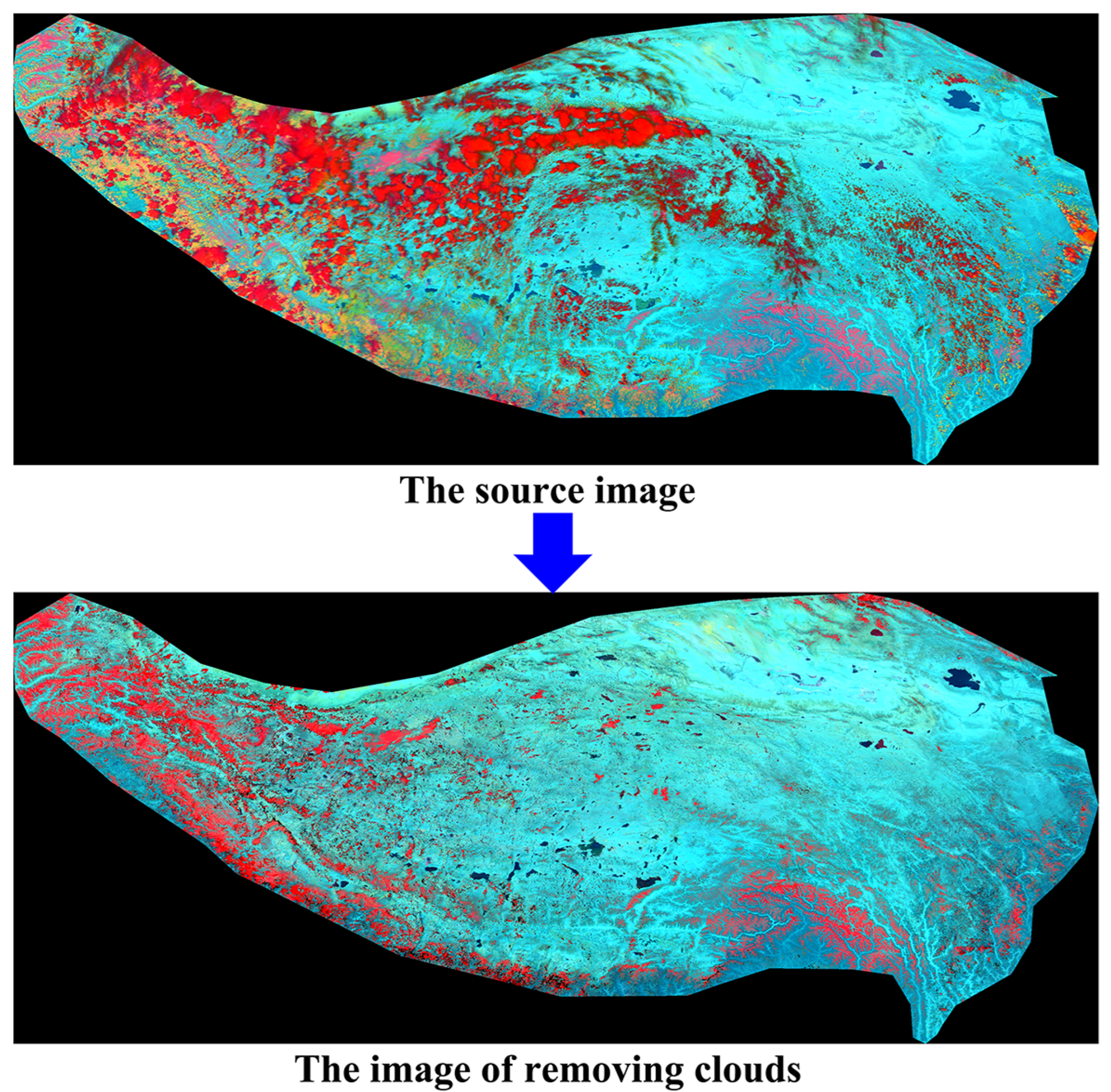

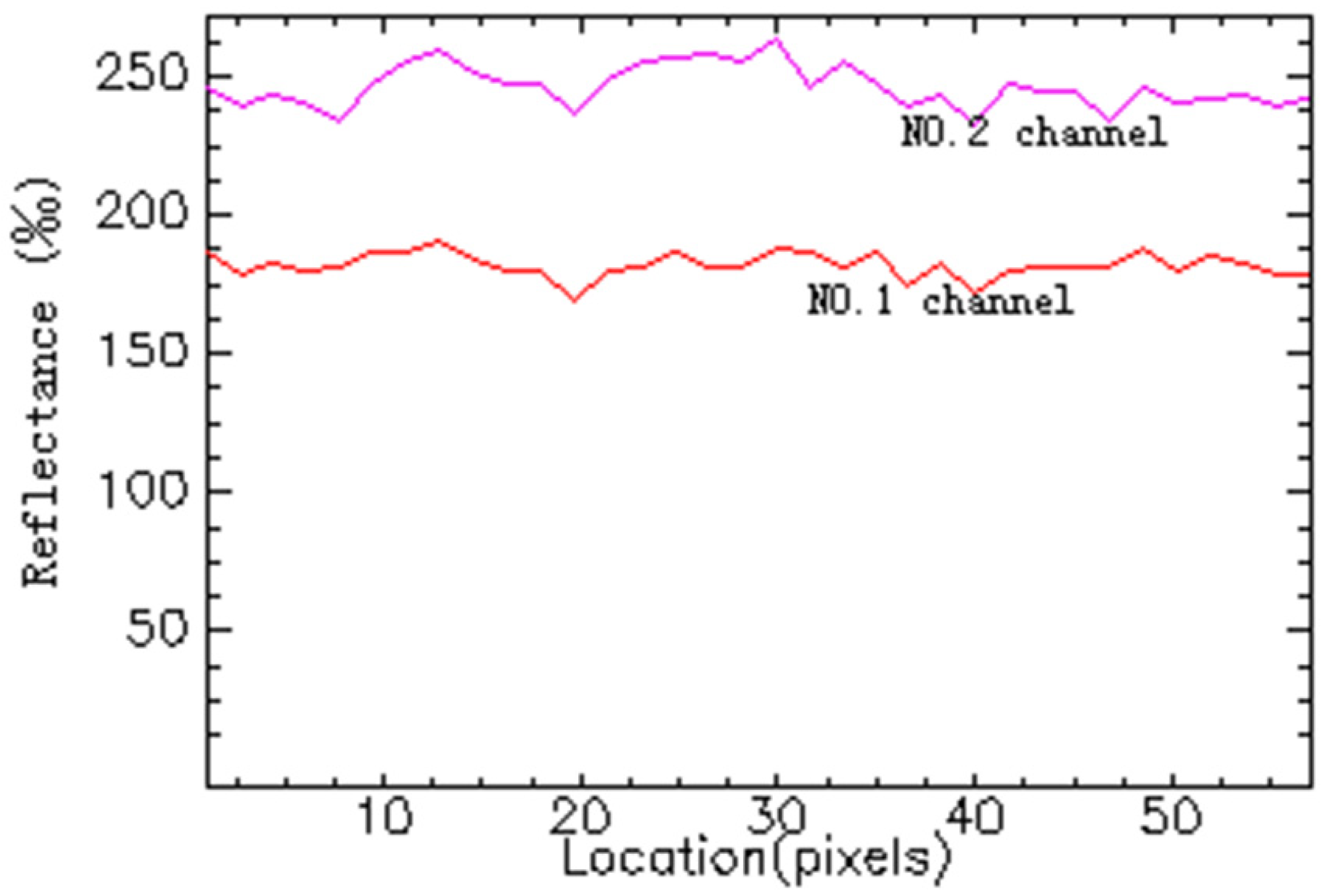
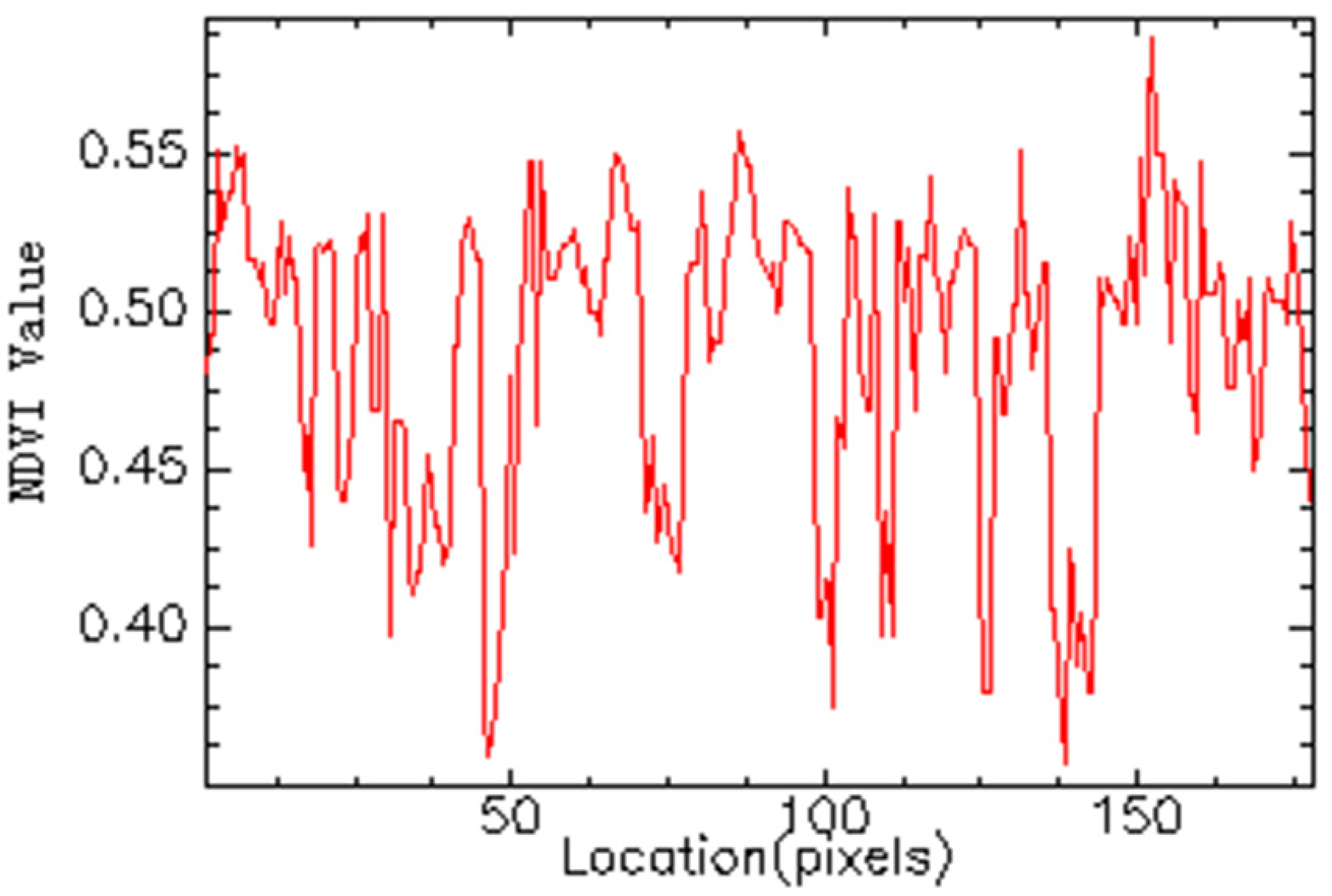
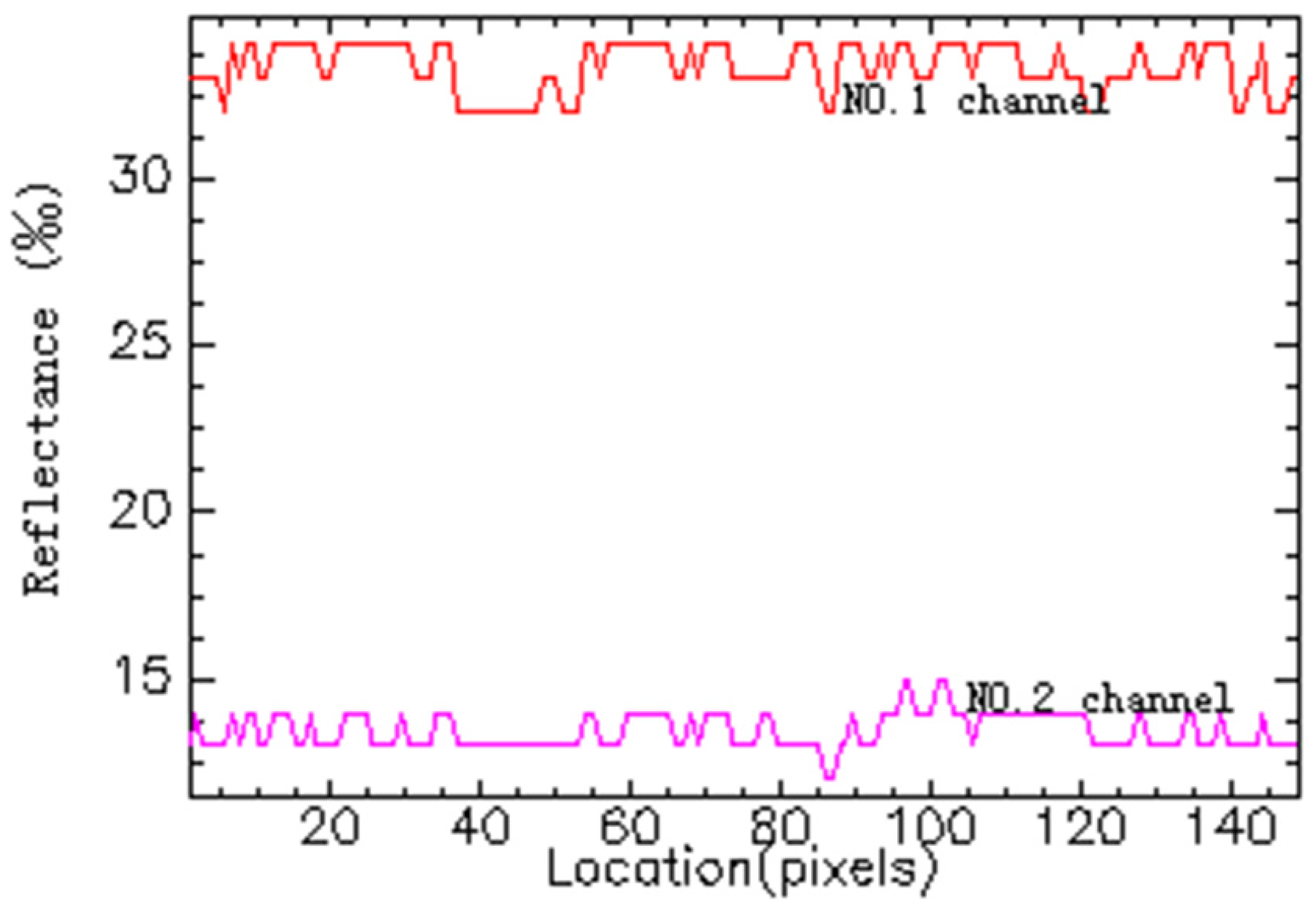

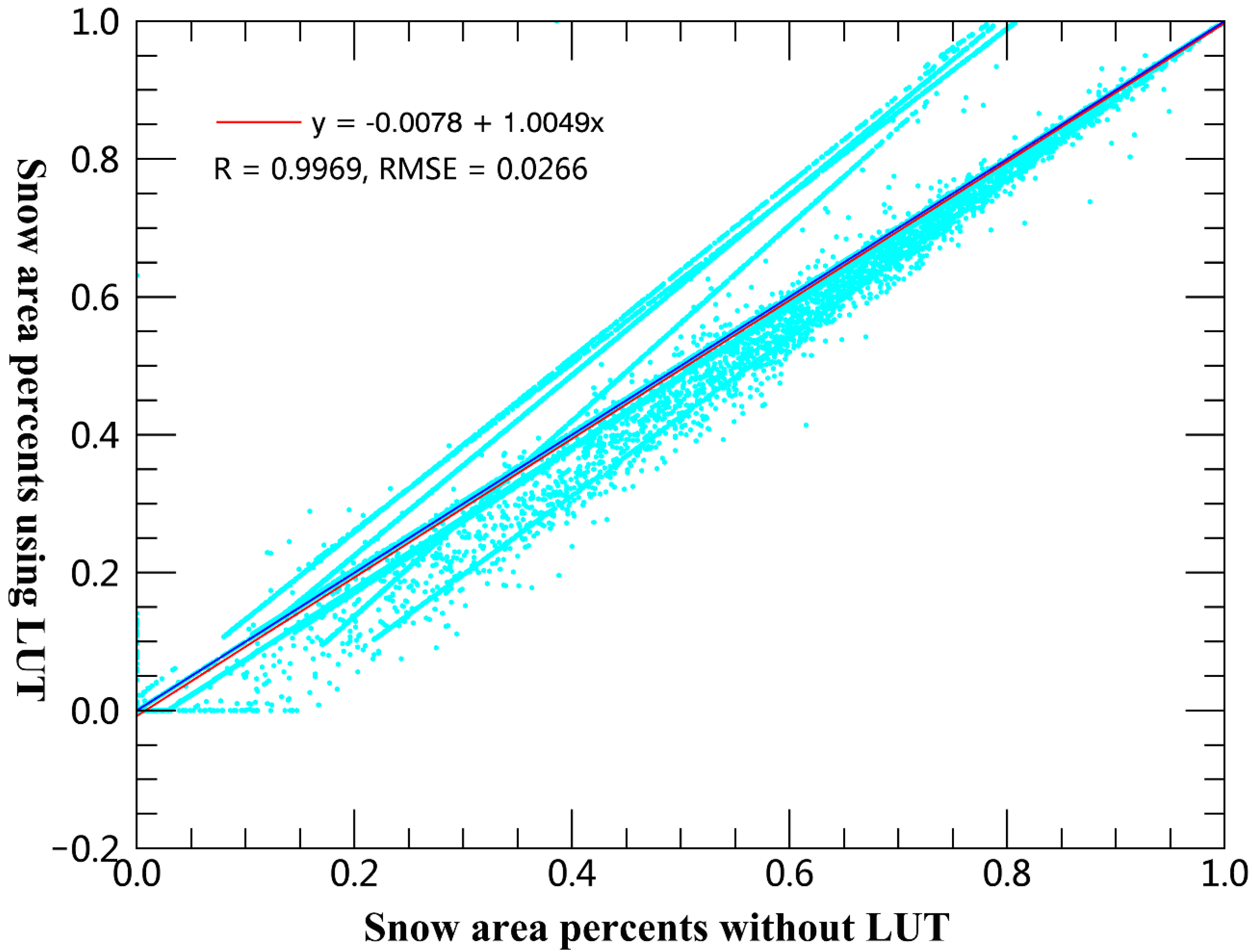
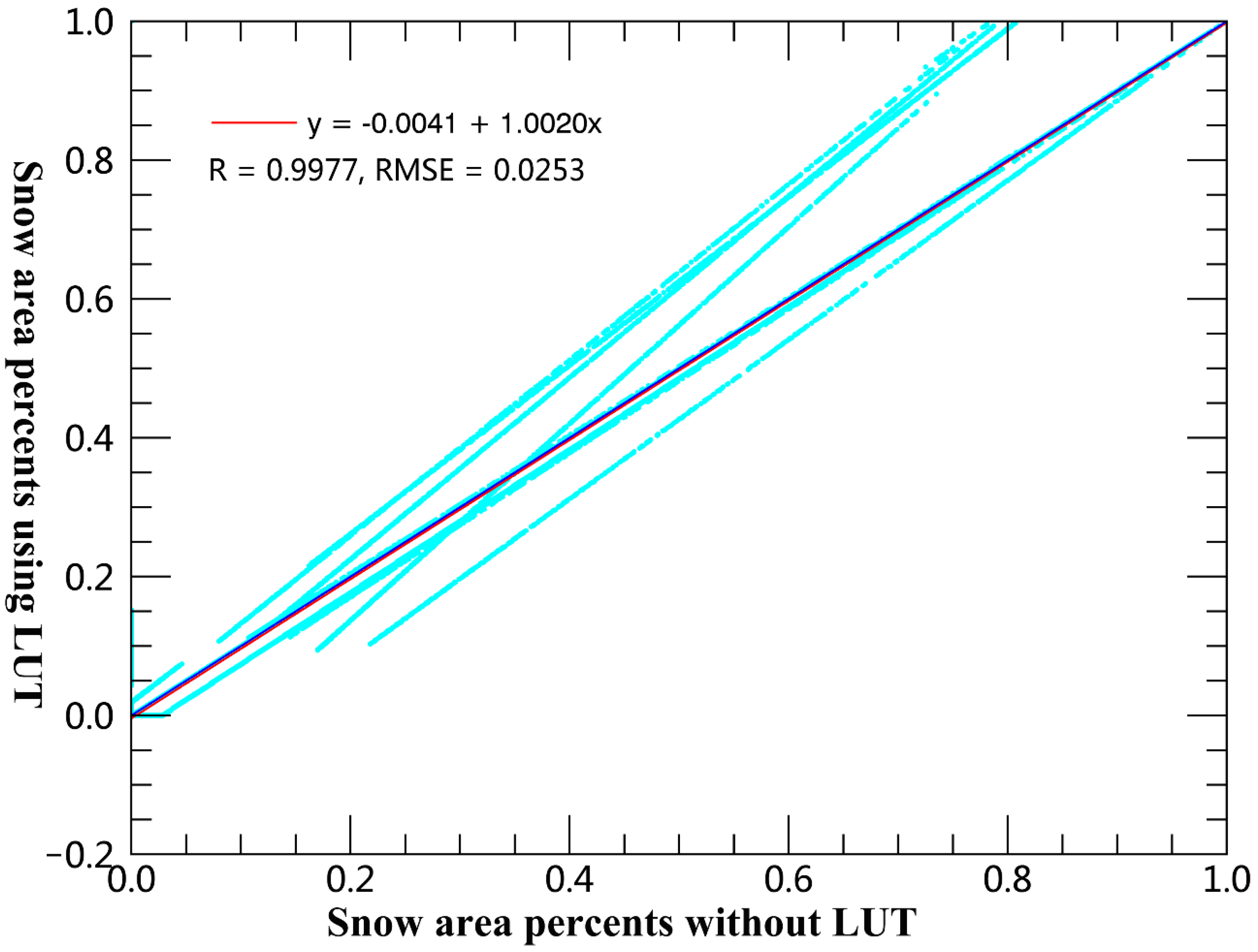
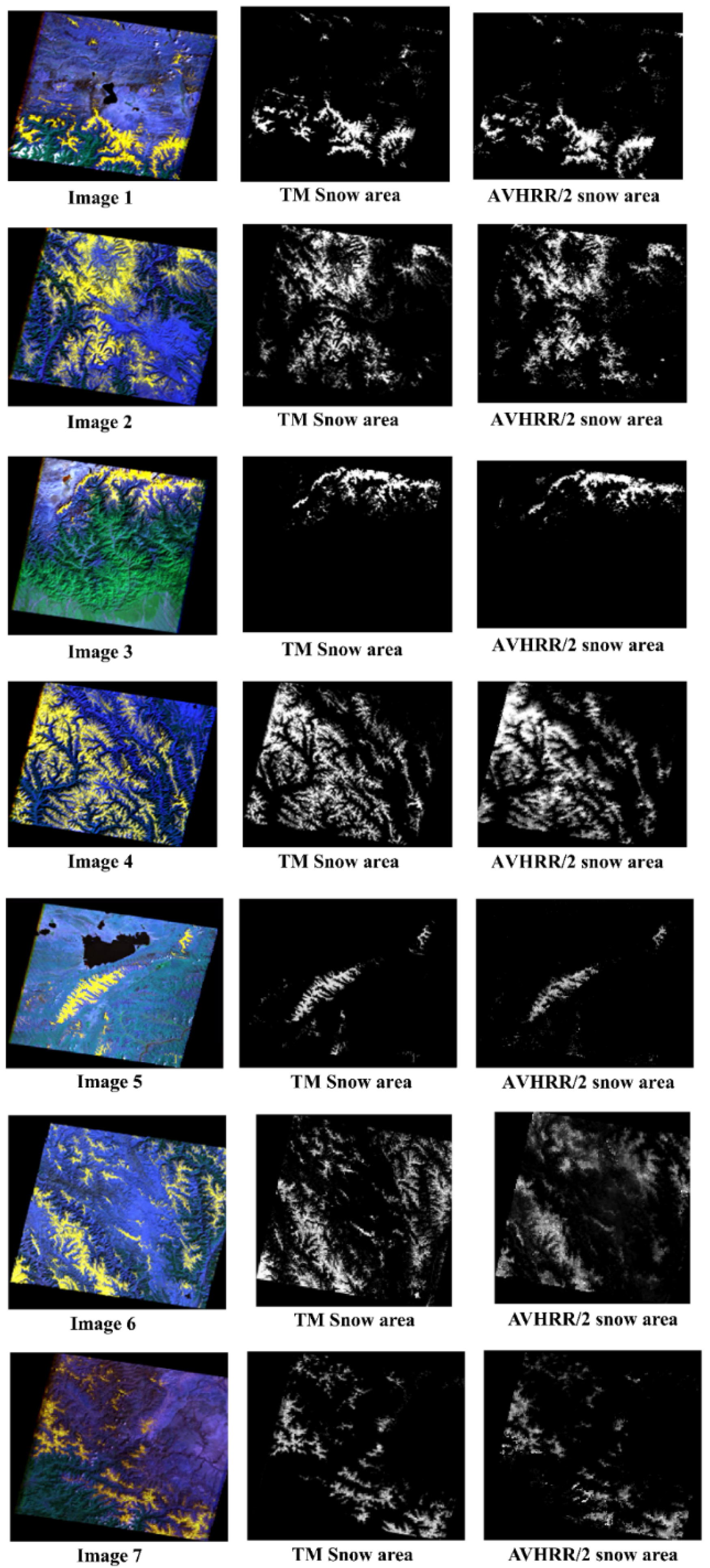
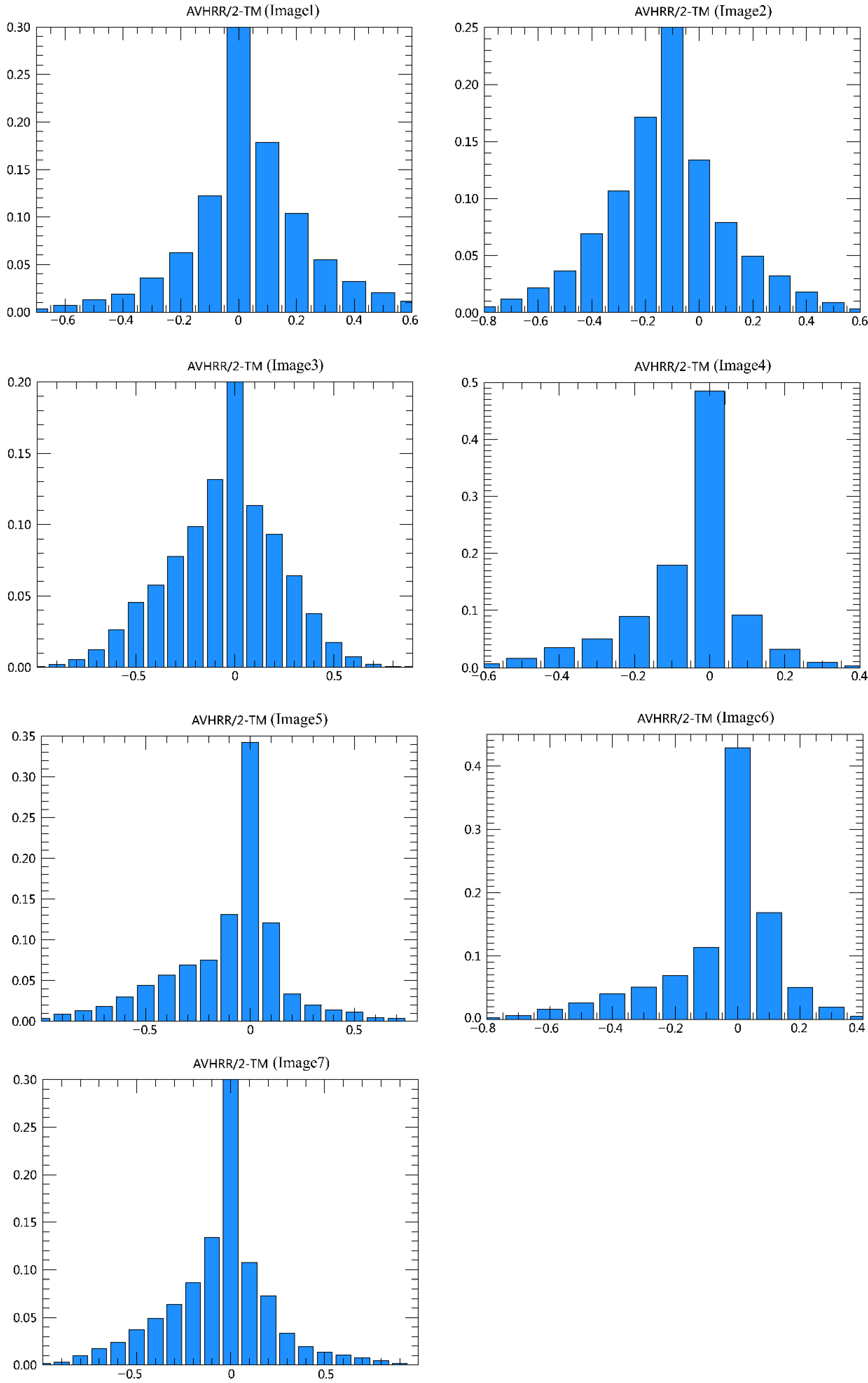
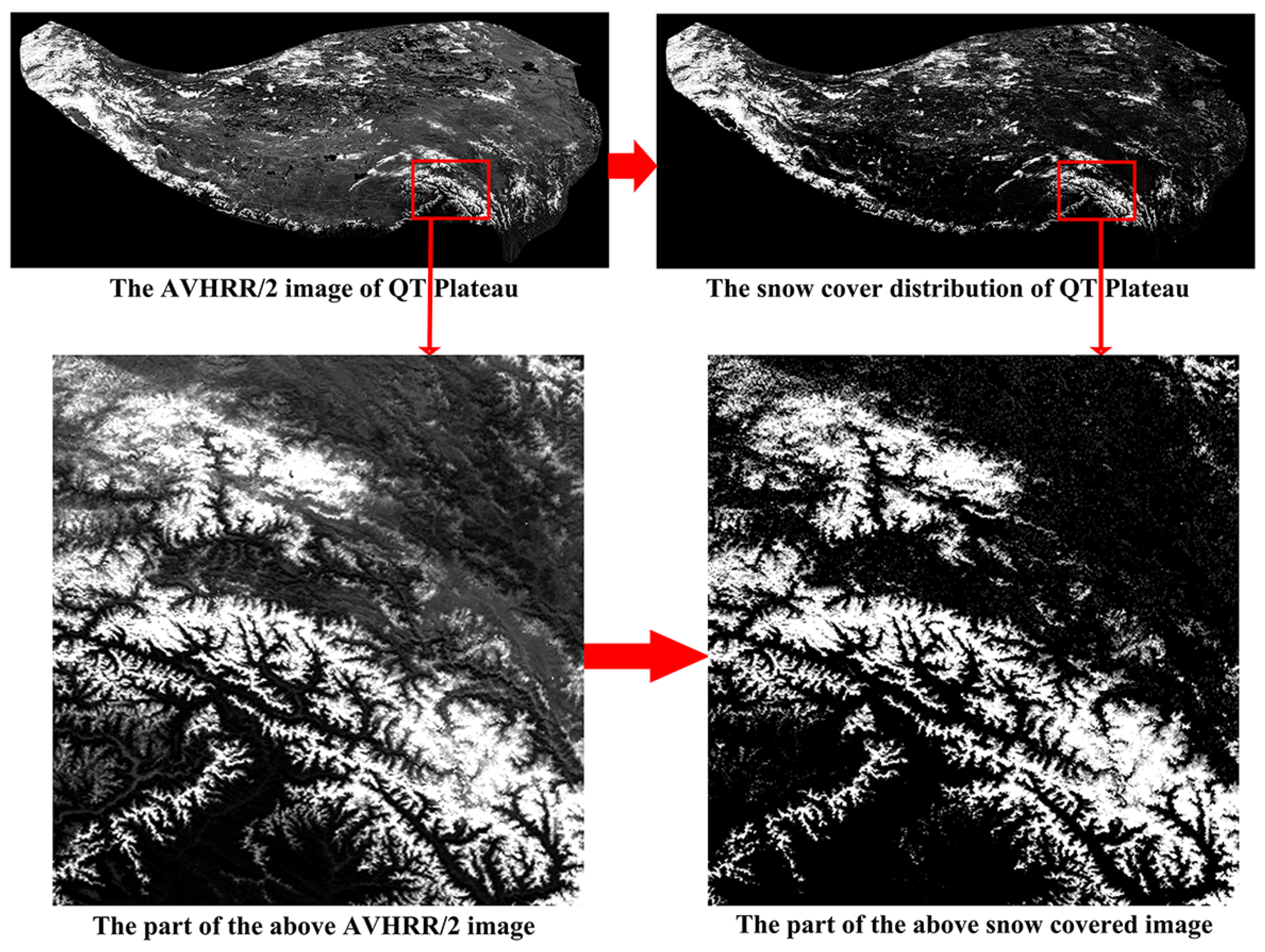
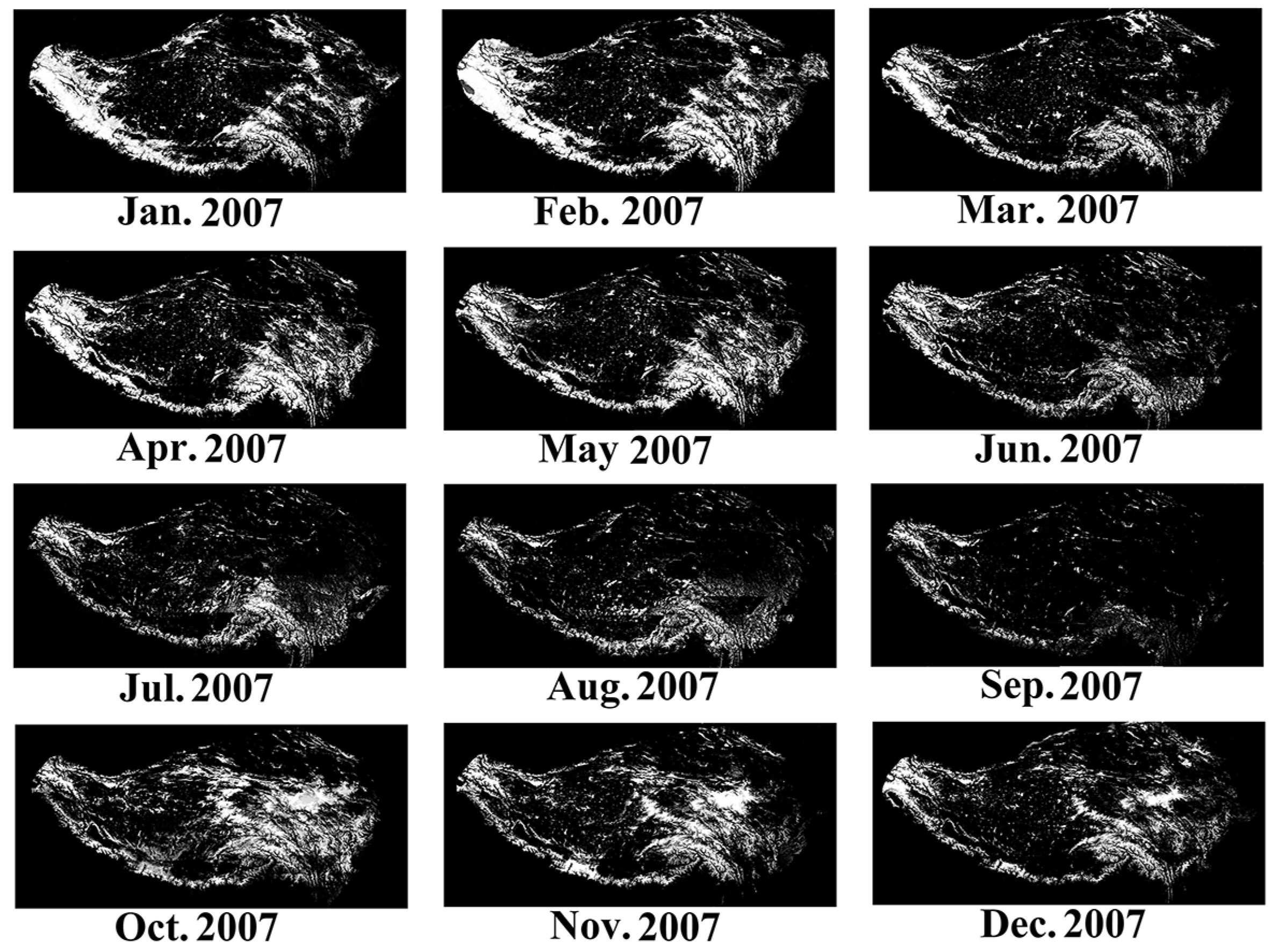
| Image | Latitude | Longitude | Orbit | Row | Date |
|---|---|---|---|---|---|
| Image 1 | 27°53′49.88″N 29°49′54.75″N | 84°28′23.30″E 86°56′34.61″E | 141 | 40 | 6 October 2006 |
| Image 2 | 29°19′14.67″N 31°15′14.35″N | 98°36′48.02″E 101°8′8.07″E | 132 | 39 | 2 December 2006 |
| Image 3 | 26°27′26.18″N 28°23′26.99″N | 88°39′26.81″E 91°5′18.76″E | 133 | 40 | 23 December 2007 |
| Image 4 | 27°56′42.85″N 29°49′13.34″N | 96°39′25.17″E 99°18′2.60″E | 138 | 41 | 25 December 2006 |
| Image 5 | 29°21′16.25″N 31°15′52.25″N | 89°22′43.10″E 91°50′19.10″E | 138 | 39 | 1 August 2017 |
| Image 6 | 29°24′36″N 31°12′0″N | 97°8′42″E 99°13′30″E | 133 | 39 | 16 November 1992 |
| Image 7 | 30°46′30.19″N 32°42′54.19″N | 77°22′30.06″E 79°36′18.06″E | 146 | 38 | 23 September 2016 |
| Image | Resolution (m) | R | R2 | RMSE |
|---|---|---|---|---|
| 1 | 1100 | 0.8760 | 0.76738 | 0.0750 |
| 2200 | 0.9136 | 0.83466 | 0.0610 | |
| 4400 | 0.9582 | 0.89208 | 0.0380 | |
| 8800 | 0.9759 | 0.9182 | 0.0262 | |
| 8800 | 0.9759 | 0.91815 | 0.0262 | |
| 2 | 1100 | 0.8555 | 0.73188 | 0.0810 |
| 2200 | 0.8898 | 0.79174 | 0.0707 | |
| 4400 | 0.9445 | 0.89208 | 0.0497 | |
| 8800 | 0.9642 | 0.9297 | 0.0402 | |
| 8800 | 0.9642 | 0.92968 | 0.0402 | |
| 3 | 1100 | 0.8461 | 0.71588 | 0.1170 |
| 2200 | 0.8802 | 0.77475 | 0.1000 | |
| 4400 | 0.9446 | 0.89226 | 0.0663 | |
| 8800 | 0.9725 | 0.9458 | 0.0466 | |
| 8800 | 0.9725 | 0.94576 | 0.0466 | |
| 4 | 1100 | 0.9067 | 0.82210 | 0.0492 |
| 2200 | 0.9389 | 0.88153 | 0.0420 | |
| 4400 | 0.9723 | 0.94537 | 0.0305 | |
| 8800 | 0.9802 | 0.96079 | 0.0229 | |
| 5 | 1100 | 0.8332 | 0.6942 | 0.0703 |
| 2200 | 0.8554 | 0.7317 | 0.0691 | |
| 4400 | 0.9404 | 0.8843 | 0.0517 | |
| 8800 | 0.9732 | 0.9471 | 0.0427 | |
| 6 | 1100 | 0.8507 | 0.72369 | 0.1104 |
| 2200 | 0.8563 | 0.73325 | 0.1087 | |
| 4400 | 0.8825 | 0.77881 | 0.1006 | |
| 8800 | 0.9172 | 0.84126 | 0.0902 | |
| 7 | 1100 | 0.8018 | 0.64288 | 0.1030 |
| 2200 | 0.8120 | 0.65934 | 0.1017 | |
| 4400 | 0.8222 | 0.67601 | 0.0827 | |
| 8800 | 0.8635 | 0.74563 | 0.0647 |
Publisher’s Note: MDPI stays neutral with regard to jurisdictional claims in published maps and institutional affiliations. |
© 2022 by the authors. Licensee MDPI, Basel, Switzerland. This article is an open access article distributed under the terms and conditions of the Creative Commons Attribution (CC BY) license (https://creativecommons.org/licenses/by/4.0/).
Share and Cite
Zhu, J.; Cao, S.; Shang, G.; Shi, J.; Wang, X.; Zheng, Z.; Liu, C.; Yang, H.; Xie, B. Subpixel Snow Mapping Using Daily AVHRR/2 Data over Qinghai–Tibet Plateau. Remote Sens. 2022, 14, 2899. https://doi.org/10.3390/rs14122899
Zhu J, Cao S, Shang G, Shi J, Wang X, Zheng Z, Liu C, Yang H, Xie B. Subpixel Snow Mapping Using Daily AVHRR/2 Data over Qinghai–Tibet Plateau. Remote Sensing. 2022; 14(12):2899. https://doi.org/10.3390/rs14122899
Chicago/Turabian StyleZhu, Ji, Shuqin Cao, Guofei Shang, Jiancheng Shi, Xinyun Wang, Zhaojun Zheng, Chenzou Liu, Huicai Yang, and Baoni Xie. 2022. "Subpixel Snow Mapping Using Daily AVHRR/2 Data over Qinghai–Tibet Plateau" Remote Sensing 14, no. 12: 2899. https://doi.org/10.3390/rs14122899







